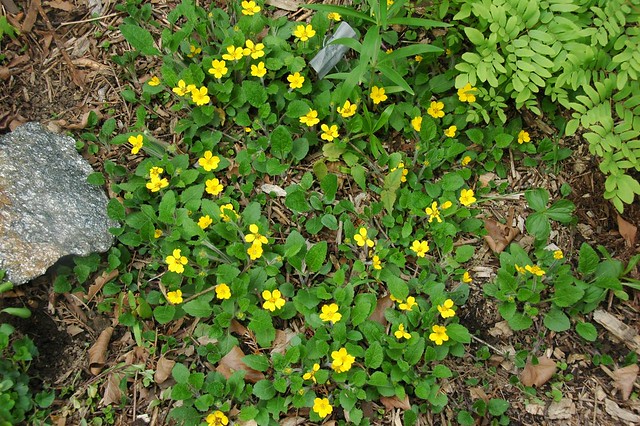Revised 2015-02-23: This was one of my earliest blog posts, first published in June 2006. I’ve overhauled it to 1) meet my current technical standards, and 2) improve the content based on the latest available information.
Chelidonium majus, Celandine or Greater Celandine, is a biennial (blooming the second year) herbaceous plant in the Papaveraceae, the Poppy family. It is native to Eurasia. It’s the only species in the genus.
It’s invasive outside its native range, and widespread across eastern North America. It emerges early in the Spring, before our native wildflowers emerge, and grows quickly to about 2 feet. That’s one of the clues to identification. It’s also one of the reasons why it’s so disruptive. The rapid early growth crowds and shades out native Spring ephemerals.
Greater celandine is one of the first weeds I identified when we bought our home in 2005 and I started the current gardens. Here’s my collection of photos from the garden’s second year, in 2006, highlighting the characteristics that help to identify this plant. The photos (click for embiggerization) show:
- Full view of plants, showing growth habit, bloom, and ripening seedpods on the same plants. The plants in this picture are about two feet tall. In the middle and lower left of the picture, you can see the leaves of Hemerocallis (Daylilies) just peeking out from under the Chelidonium.
- Broken stem with orange sap. You can also see a small flower bud in the leaf axil to the left.
- Detail of flower. Notice the 4 petals, clustered stamens, and central pistil with white stigma.
- Detail of ripening seedpod. These seedpods are what made me think at first that this plant was in the Brassicaceae (or, if you’re old-school like me, the Cruciferae), the Mustard family. It’s actually in the Papaveraceae (Poppy family).
At the time these pictures were taken in early June, these plants had already been blooming for two months. After I took these pictures, I removed all the plants (and there were many more than are visible in these photos!).
Part of coming to any new garden is learning the weeds. There are always new ones I’ve never encountered before, or that I recognize but am not familiar with. Learning what they are, how invasive or weedy they are, their lifecycle, how they propagate, and so on helps me prioritize their removal and monitor for their return.
For example, Chelidonium is a biennial. So pulling up visible plants before their seeds ripen and disperse kills this year’s generation and the generation two years from now. I might overlook next year’s generation this spring, but I’ll get them next year. The plants are shallowly rooted. By grabbing the plant at the base of the leaves, I can remove the whole thing easily, roots and all.
Chelidonium‘s seeds are dispersed by ants. They’re likely to show up next year close to where they were this year, but not necessarily in the same place. In addition, the soil probably has a reservoir of seeds from the years the garden was neglected. If I disturb the soil, or transplant plants from one part of the yard to another, they could show up in new places. By pulling the plants when they emerge in the spring, and keeping an eye out for their emergence in new places in the garden, I can easily control them. It will take a few years of vigilant weeding to eliminate them completely.
Note that, at a quick glance, this plant can be confused with the native* wildflower Stylophorum diphyllum, celandine-poppy. They’re very similar. Both are in the Papaveraceae, bloom in the spring with four-petaled yellow flowers, have lobed foliage and bright orange/yellow sap, and are about the same height. I find the seedpods the easiest way to distinguish them. The flowers of Stylophorum lack the prominent tall central pistil of Chelidonium, and the stamens form more of a “boss” around the center of the flower, not so obviously grouped in four clusters.
Stylophorum diphyllum, celandine-poppy, blooming and showing the distinctive, more poppy-like, ripening seedpods, in my urban backyard native plant garden, May 2013.
* Stylophorum isn’t native, or present, in New York. But it is native to eastern North America.
Related Content
Flickr photo sets:
References





























